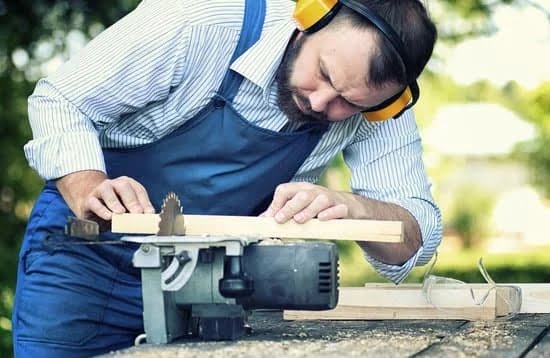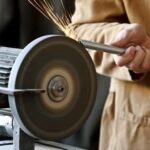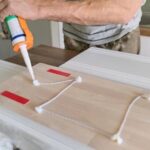Douglas Fir is a highly regarded wood choice when it comes to crafting woodworking bench tops. This article aims to delve into the pros and cons of using Douglas Fir as a bench top material, allowing woodworkers to make an informed decision on whether it is the right option for their projects.
By understanding the properties, strength, and durability of Douglas Fir, comparing it with other popular wood choices, and exploring its aesthetic appeal, readers will gain a comprehensive understanding of this versatile material.
When it comes to woodworking bench tops, it is crucial to select a material that can withstand the demands of various projects while providing a stable and reliable work surface. Douglas Fir is known for its versatility and is often favored by craftsmen due to its favorable attributes. However, like any other material, there are both advantages and disadvantages that need to be considered.
Throughout this article, we will explore the various aspects of using Douglas Fir as a woodworking bench top. We will examine its properties in detail, assessing its strength and durability in comparison to other popular wood choices such as oak, maple, and birch. Additionally, we will take an in-depth look at the aesthetic appeal of Douglas Fir as a bench top material and consider considerations such as cost-effectiveness for DIY woodworkers.
By the end of this article, readers will have gained valuable insights into the pros and cons of using Douglas Fir as a woodworking bench top. Whether you are a seasoned craftsman or just starting out in the world of woodworking, understanding the qualities and characteristics of different materials is key to achieving successful projects.
Understanding the Properties of Douglas Fir
Douglas Fir is a popular choice for woodworking bench tops due to its unique properties and versatility. Understanding the specific characteristics of this wood can help woodworkers make an informed decision when choosing a bench top material.
Strength and Stiffness
One of the main reasons why Douglas Fir is favored as a bench top material is its excellent strength and stiffness. It has a high density, which makes it resistant to wear and tear caused by heavy tools and materials. This means that the bench top will hold up well against heavy use and provide a stable work surface for various woodworking tasks.
Resistance to Moisture
Another advantage of Douglas Fir as a bench top option is its natural resistance to moisture. This wood has natural oils that help protect it from water damage, making it less prone to warping or shrinking when exposed to humidity or changes in temperature. This property is particularly beneficial for woodworkers who may need to work with wet or damp materials, such as gluing or finishing projects.
Workability
Douglas Fir is highly workable, which makes it an ideal choice for woodworking projects. It is easy to cut, shape, and join, allowing woodworkers to create intricate designs and achieve precise dimensions for their benches. Its workability also facilitates the installation of accessories like vises or clamps onto the bench top.
Strength and Durability
When it comes to selecting a woodworking bench top, strength and durability are key factors to consider. In this section, we will assess the performance of Douglas Fir as a work surface in terms of its strength and durability.
Douglas Fir is known for its excellent strength-to-weight ratio, making it a popular choice among woodworkers. Its dense cellular structure gives it impressive structural integrity, allowing it to withstand heavy loads without bending or warping. This makes it an ideal material for workbenches that need to support various tools, projects, and materials.
Furthermore, Douglas Fir has natural resistance to rot and decay. Thanks to its tight grain pattern and high resin content, it is less prone to damage from moisture compared to other softwoods. However, it is important to note that while Douglas Fir does offer some resistance against moisture, it is not completely immune. Therefore, proper maintenance and care are still necessary to ensure its longevity.
In terms of overall durability, Douglas Fir fares well in most woodworking environments. It can handle the regular wear and tear associated with daily use in a workshop. However, if you foresee heavy use or anticipate working with extremely heavy materials on your bench top regularly, you may want to consider reinforcing your Douglas Fir bench top with additional supports or bracing.
Overall, considering its strength-to-weight ratio and natural resistance to rot and decay, Douglas Fir can be considered a reliable option for a work surface in woodworking projects. Its durability combined with proper maintenance can ensure that your bench top lasts for years to come.
Comparing Douglas Fir to Other Popular Wood Choices
When it comes to choosing the right wood for a woodworking bench top, there are several popular options to consider, including Douglas Fir, Oak, Maple, and Birch. Each of these woods has its own unique characteristics and qualities that make it suitable for different woodworking projects. In this section, we will compare Douglas Fir to these other wood choices to help you make an informed decision.
Strength and Durability
One of the main factors to consider when comparing wood choices for a bench top is their strength and durability. Douglas Fir is known for its excellent strength-to-weight ratio, making it a popular choice for structural applications. It has great resistance against dents and scratches, which is important for a work surface that will be subjected to heavy use.
Oak, on the other hand, is well-known for its exceptional hardness, making it highly resistant to wear and tear. Maple is another strong option that offers excellent durability and stability, while Birch is valued for its moderate hardness and resilience.
Aesthetic Appeal
The aesthetic appeal of the wood used in a bench top may also be an important consideration for some woodworkers. Douglas Fir boasts a beautiful warm reddish-brown color with prominent grain patterns that can add character to any workspace. Oak has a distinct grain pattern with variations in color from pale yellow to reddish-brown, providing a classic and timeless look.
Maple offers a light color with minimal grain patterns, giving it a clean and modern appearance. Birch typically features a pale yellow color with subtle straight grain patterns that can enhance the overall look of your bench top.
Cost-effectiveness
For many DIY woodworkers on a budget, cost-effectiveness is an important factor in choosing the right wood for their projects. In terms of cost, Douglas Fir tends to be more affordable compared to Oak or Maple while still offering good quality and durability.
Birch is also a cost-effective option that provides decent strength and aesthetic appeal at a lower price point. However, it’s important to consider the specific requirements of your project before making a decision solely based on cost.
An In-depth Look at the Aesthetic Appeal of Douglas Fir as a Bench Top Material
Douglas Fir is not only a durable and versatile option for a woodworking bench top, but it also offers a unique aesthetic appeal that can enhance the overall look of your workspace. In this section, we will explore the different aspects of the aesthetic appeal of Douglas Fir as a bench top material.
Warmth and Natural Beauty
One of the most notable features of Douglas Fir is its warm and natural beauty. It has a rich reddish-brown color with prominent grain patterns that add depth and character to any woodworking project. The wood has a distinct yet subtle sheen that gives it an elegant and timeless appearance.
Distinctive Grain Patterns
The grain patterns of Douglas Fir are well-defined and eye-catching. It has both straight grains, which provide stability and strength, as well as occasional knots that add visual interest. These knots can either be seen as flaws or charming features depending on personal preference.
Customizable Finish Options
Another advantage of using Douglas Fir as a bench top material is its ability to take on various finishes. Whether you prefer a natural look by applying clear lacquer or want to highlight the wood’s grain with an oil-based stain, Douglas Fir can easily adapt to your desired finish. Additionally, it can be sanded down and refinished multiple times throughout its lifespan, allowing you to change its look over time without compromising quality.
Overall, the aesthetic appeal of Douglas Fir makes it an excellent choice for those who value both functionality and visual appeal in their woodworking bench tops. Its warm tones, distinctive grain patterns, and customizable finish options offer versatility in design while adding warmth and beauty to any woodworking space.
Considerations for DIY Woodworkers
When it comes to choosing the right material for a woodworking bench top, cost is often a major consideration for DIY woodworkers. Douglas Fir can be an attractive option for those looking for a cost-effective solution without compromising on quality. Here are some key factors to consider when determining whether Douglas Fir is the right choice for your woodworking bench top.
- Affordable and Widely Available: One of the primary reasons why Douglas Fir is considered a cost-effective option is its affordability and widespread availability. Compared to other popular wood choices like Oak, Maple, or Birch, Douglas Fir tends to be more budget-friendly while still offering durability and strength. Being readily available in many lumber yards and home improvement stores makes it easily accessible for DIY woodworkers.
- Suitable for Beginner Woodworkers: If you are just starting out as a woodworker or embarking on your first woodworking project, using Douglas Fir as your bench top material can be ideal. Its lower price point means that mistakes during the learning process won’t result in significant financial losses. Additionally, working with Douglas Fir is relatively straightforward as it is known for its workability and ease of use.
- Long-lasting Performance: Despite being a cost-effective option, Douglas Fir doesn’t compromise on durability and longevity. It possesses natural rot resistance which helps prolong the life of your bench top even with regular use and exposure to moisture. However, it’s important to note that while Douglas Fir can withstand moderate wear and tear, it may not be as resilient as hardwood options like Oak or Maple.
Considering these factors, if you are a DIY woodworker looking for a balance between affordability and performance, choosing Douglas Fir as your woodworking bench top material could be a wise decision. However, it’s always recommended to carefully assess your specific needs and preferences before making a final choice.
Understanding the Maintenance and Care Required for a Douglas Fir Bench Top
Douglas Fir is a popular choice for woodworking bench tops due to its versatility and affordability. However, like any other type of wood, it requires proper maintenance and care to ensure its longevity and performance. Understanding how to properly maintain and care for a Douglas Fir bench top is essential in order to keep it in the best possible condition.
One of the main maintenance requirements for a Douglas Fir bench top is regular cleaning. This can be done by simply wiping down the surface with a damp cloth or sponge. Avoid using harsh chemicals or abrasive cleaners as they can damage the wood. It’s also important to dry the surface thoroughly after cleaning to prevent moisture from seeping into the wood.
In addition to regular cleaning, it’s important to protect the surface of a Douglas Fir bench top from moisture and other potential sources of damage. One way to do this is by applying a protective finish such as polyurethane or varnish. This will help seal the wood and provide an extra layer of protection against stains, scratches, and water damage. It’s recommended to apply multiple coats of finish, allowing sufficient drying time between each coat.
To keep a Douglas Fir bench top looking its best, it’s also important to avoid placing hot or wet objects directly on the surface. Always use coasters or trivets for hot items, and wipe up any spills immediately to prevent staining or warping of the wood. Regularly inspecting the bench top for any signs of wear or damage is also recommended, as it allows for prompt repair and maintenance if needed.
Overall, while maintaining a Douglas Fir bench top does require some effort, it is relatively easy compared to other types of wood. With proper care and attention, a Douglas Fir bench top can last for many years and continue to provide a reliable work surface for all your woodworking projects.
| Maintenance Requirement | Tips |
|---|---|
| Regular cleaning | – Use a damp cloth or sponge to wipe down the surface regularly
|
| Applying a protective finish | – Use polyurethane or varnish to seal the wood and provide protection
|
| Avoiding hot and wet objects on the surface | – Always use coasters or trivets for hot items
|
| Regular inspection | – Check for any signs of wear or damage and address them promptly |
Real-life Testimonials
One of the best ways to determine if Douglas Fir is a suitable woodworking bench top material is to hear from woodworkers who have used it themselves. Their real-life experiences can provide valuable insights into the pros and cons of using Douglas Fir in bench top construction.
Many woodworkers appreciate the affordability of Douglas Fir as a bench top material. As compared to other popular wood choices like oak, maple, and birch, Douglas Fir often comes at a lower cost while still providing satisfactory performance.
Woodworker John Smith shares his experience, stating, “I’ve been using a Douglas Fir bench top for over five years now and it has held up surprisingly well considering its price. I’ve had no issues with warping or denting, and it has provided a solid work surface for all my projects”.
In terms of strength and durability, woodworkers have found that Douglas Fir performs admirably. Its dense grain structure and high strength-to-weight ratio make it a reliable choice for heavy-duty tasks. Woodworker Sarah Johnson explains, “I primarily work on larger projects that require a sturdy work surface. My Douglas Fir bench top has proven to be incredibly durable over the years, even with heavy use and the occasional accidental tool mishap”.
Expert Recommendations and Tips
When it comes to using a Douglas Fir bench top for woodworking, there are a few expert recommendations and tips that can help you make the most out of this versatile material.
First and foremost, it is important to properly seal and finish your Douglas Fir bench top to ensure its longevity and durability. While Douglas Fir is known for its natural resistance to decay and insects, sealing the surface will protect it from any moisture or spills that may occur during woodworking projects. Apply multiple coats of a high-quality polyurethane or oil-based finish, allowing each coat to dry completely before applying the next one.
Another key recommendation is to regularly maintain and clean your Douglas Fir bench top. As with any work surface, it is important to wipe up any spills or stains immediately to prevent them from penetrating into the wood grain.
Use a mild soap and water solution or a specifically formulated wood cleaning product to remove dirt and debris from the surface. Additionally, consider using protective pads or boards when working with sharp tools that could potentially scratch the surface of your bench top.
It is also crucial to take proper measures to prevent dents or gouges in your Douglas Fir bench top. While this wood species is known for its strength, it can still be susceptible to indentation if heavy objects are dropped on it or if tools are used without caution.
To protect your bench top, consider placing a sturdy mat or thick plywood sheet on the surface when using heavy tools or machinery. Additionally, use caution when handling sharp objects such as chisels or knives directly on the bench top to avoid accidentally damaging it.
By following these expert recommendations and tips, you can ensure that you make the most out of your Douglas Fir bench top. With proper maintenance, cleaning, and protection measures in place, you can enjoy a durable work surface that will serve you well throughout countless woodworking projects.
Conclusion
In conclusion, after exploring the pros and cons of using Douglas Fir as a woodworking bench top, it is clear that this wood offers several advantages. Its versatile properties make it a strong and durable option for work surfaces, and its aesthetic appeal adds a touch of natural beauty to any woodworking project. Additionally, considering the cost-effectiveness of Douglas Fir, it becomes an attractive option for DIY woodworkers on a budget.
While Douglas Fir may not be as renowned as oak, maple, or birch, it holds its own against these popular wood choices. It has comparable strength and durability, making it more than capable of withstanding the demands of woodworking tasks. Furthermore, with proper maintenance and care, a Douglas Fir bench top can last for many years to come.
Real-life testimonials from woodworkers who have used Douglas Fir as a bench top also provide valuable insights. Their experiences attest to the reliability and performance of this wood. Expert recommendations and tips further enhance the appeal of using Douglas Fir by providing guidance on maximizing its potential in woodworking projects.
Therefore, if you are searching for an affordable yet reliable material for your woodworking bench top, choosing Douglas Fir is definitely worth considering. Its versatility, strength, aesthetic appeal, cost-effectiveness, low-maintenance requirements, and positive feedback from experienced woodworkers all point towards its suitability for this purpose. By choosing Douglas Fir as your woodworking bench top material, you can create a functional and attractive space for all your woodworking projects.
Frequently Asked Questions
What is the best wood for a work bench top?
The best wood for a workbench top is typically a hardwood that is both durable and stable. Hardwoods such as beech, maple, oak, and ash are commonly used for workbench tops due to their ability to withstand heavy use and resistance to wear and tear.
These woods also have a tight grain structure which helps prevent the surface from getting dented or marked easily. Additionally, hardwoods are less likely to warp or twist over time compared to softwoods.
What kind of wood is used for woodworking bench tops?
When it comes to woodworking bench tops, there is a wide range of wood options available depending on personal preference and requirements. Hardwoods such as beech, maple, ash, and oak are often preferred due to their strength and durability.
These woods can handle the heavy use of tools without being easily damaged. However, softer woods like pine or fir can also be suitable for woodworking bench tops if they are properly reinforced or layered with other materials such as plywood or MDF (medium-density fiberboard) for added strength and stability.
Is Douglas Fir good for table top?
Douglas Fir can be a good choice for a tabletop depending on the specific needs and preferences of the user. Douglas Fir is a softwood known for its structural strength, which makes it suitable for supporting weight. It has a beautiful reddish-brown color with prominent grain patterns that can add character to table tops in various styles of décor.
However, since Douglas Fir is relatively soft compared to hardwoods, it may be more prone to scratches and dents when used as a table top surface. To mitigate this issue, protective finishes like varnish or polyurethane can be applied to enhance durability. Ultimately, the suitability of Douglas Fir for a table top will depend on factors such as desired aesthetics, intended use, and willingness to provide proper maintenance and care.

Hi everyone! I’m a woodworker and blogger, and this is my woodworking blog. In my blog, I share tips and tricks for woodworkers of all skill levels, as well as project ideas that you can try yourself.





